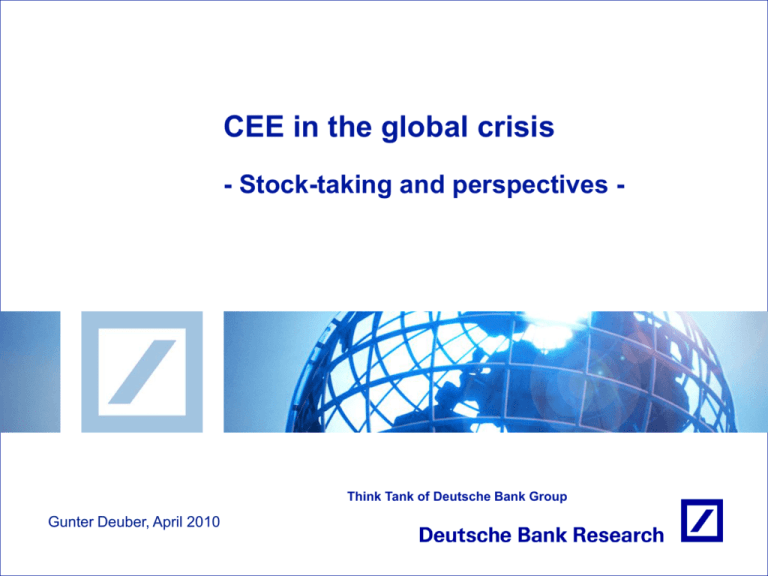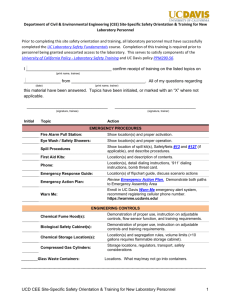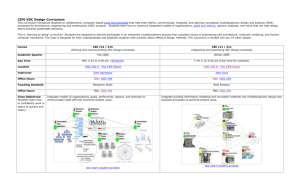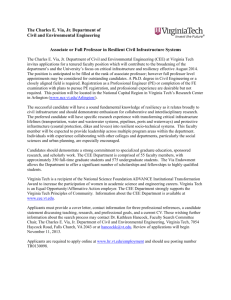
CEE in the global crisis
- Stock-taking and perspectives -
Think Tank of Deutsche Bank Group
Gunter Deuber, April 2010
Agenda
1
After crisis year 2009, 2010 remains challenging
2
Some comments on recent eye-catchers in CEE
3
Summary & Outlook
1
CEE in the global crisis
Risk of economic setback initially underestimated
Strongest setback in growth
(expectations) in CEE & CIS
Setback in CEE was stronger than in
most other regions (DM & EM)
Real GDP growth (forecasts and final
outcome for the year 2009), % yoy
6
4
2
0
-2
-4
-6
-8
-10
-12
0
-2
-4
-6
Global crisis has hit CEE as “perfect
storm”
-8
-10
-12
-14
World
EA
EM
CEE
CIS
IMF WEO 08 forecast (left)
IMF WEO 09 forecast (left)
Final outcome (left)
Difference WEO 08 WEO 09, percentage points (right)
Source: IMF, DB Research
Gunter Deuber, April, 2010
Page 3
Better outcome than in IMF’s WEO
2009 forecast mainly driven by
Poland’s weight in the CEE
aggregate
1
CEE in the global crisis
Current account adjustment comparable to Asian crisis
Substantial current account
adjustment within 1 year
CEE: Adjusting to new reality
8
Change in the current account balance in % of
GDP, percentage points
6
4
12
10
2
8
0
6
-2
4
-4
2
-6
0
-8
-2
-10
t-5
t-4
t-3
CEE
t-2
t-1
t0
t+1
ASEAN-5
2005
2006
2007
Current account, % of GDP
CEE t0=2009; ASEAN t0=1998.
Sources: IMF, DB Research
Gunter Deuber, April, 2010
2004
Source: National sources, DB Research
Page 4
2008
2009
2010E
Real GDP, % yoy
1
CEE in the global crisis
What‘s the difference to the Asian crisis
Large on-shore presence of foreign
banks plus coordinated action
(private + public sector)
Trade performance CEE (2009)
vs. ASEAN-5 (1998)
% yoy
30
25
20
15
10
5
0
-5
-10
-15
-20
Early IMF/EU support and increased
flexibility in IMF/EU conditionality
t-8
t-7
t-6
t-5
t-4
t-3
t-2
t-1
t0
t+1
CEE export volume of goods
CEE import volume of goods
ASEAN-5 export volume of goods
ASEAN-5 import volume of goods
Sources: IMF, DB Research
Gunter Deuber, April, 2010
Page 5
Weak backdrop in most DM (incl.
major EU countries) will not bode
well for a strong and sustainable
export-led recovery
1
CEE in the global crisis
Different crisis reaction in comparison to Euro area strongly differing performance in the global crisis
CEE: Low saving rates, soaring
consumption
Striking country differences
in coping with the global crisis
Gross national savings, % of GDP, private
consumption, % yoy
23
21
19
17
15
15
10
10
5
8
0
6
-5
4
-10
2
-15
0
-20
-2
-25
97
99
01
03
05
07
09
15
10
5
0
97
99
01
03
05
07
09
CEE maximum* real GDP, % yoy (left)
CEE minimum* real GDP, % yoy (left)
Difference Max Min GDP growth rate (right)
Savings Euro area (left)
Savings CEE (left)
Private consumption Euro area (right)
Private consumption CEE (right)
* Maximum and minimum growth rate among all CEE.
Sources: IMF, DB Research
Gunter Deuber, April, 2010
20
95
-4
95
25
Sources: IMF, national sources, DB Research
Page 6
1
CEE in the global crisis
2010 will remain challenging for CEE banks
A lot of adjustment in the real
economy and the banking sectors did
take place already
Rise in NPLs and unemployment
to bottom out later in 2010
NPLs in % of total loans (nat. definition),
30
25
20
15
10
5
0
CZ
HU
PL
EE
BG
LT
RO
LV
NPLs, 2008 eop
NPLs, latest value
Unemployment, 2008 eop
Unemployment, latest value
NPLs peak level forecast lower bound*
NPLs peak level forecast upper bound*
Forecasts for NPL peak level DBR Credit Monitor Eastern Europe,
Sources: Eurostat, nat. central banks and regulators, DB Research
Gunter Deuber, April, 2010
Page 7
However, CEE will remain the most
vulnerable EM region due to high
external financing requirements and
debt overhang
NPLs and unemployment to peak
later in 2010, only sluggish
downtrend afterwards
1
CEE in the global crisis
Maastricht criteria in reach – be prepared for challenging
sovereign debt outlook in developed markets
CEE: Debt criterion well in reach
Welcome to a new world!
Budget deficit, % of GDP (y-axis), public debt,
% of GDP (x-axis)
Public debt*, % of GDP (baseline)
140
120
-9
LV
-7
RO
-5
EE
-3
-1
LT
LV
1
SI
SK
RO
BG
BG
LT
100
PL
CZ
80
HU
60
HU
40
PL
SK
CZ
20
SI
0
95 97 99 01 03 05 07 09 11 13 15 17 19
EE
3
0
20
2007
40
60
2010
80
Emerging markets
*GDP-weighted. Source: DB Research, Public Debt in 2020
Sources: Eurostat, DB Research
Gunter Deuber, April, 2010
Developed markets
Page 8
1
CEE in the global crisis
CEE to profit from export-led rebound in Germany and
its close trade links to Europe‘s export hub
Sluggish Eurozone recovery …
… but CEE to join EM recovery
Real GDP, % yoy
Real GDP, % yoy
8
6
6
4
4
2
2
0
0
-2
-4
-2
-6
-4
-8
-10
2008
-6
2008
G7
2009E
US
EA
2010F
DE
2011F
Euroland
PL
CEE
Sources: DB Global Markets Research, DB Research
Gunter Deuber, April, 2010
2009
2010F
CZ
RU
Sources: national sources, DB Research
Page 9
2011E
HU
EM
Agenda
1
After crisis year 2009, 2010 remains challenging
2
Some comments on recent eye-catchers in CEE
3
Summary & Outlook
2
CEE in the global crisis
Some comments on recent eye-catchers in CEE
What is the reason for Poland’s outstanding economic performance?
Was it a mistake to develop export-oriented industries that suffered much from
shrinking EU markets?
Has it been an advantage to be in the Eurozone?
Will western banks be able to support their CEE subsidiaries?
Gunter Deuber, April, 2010
Page 11
2
CEE in the global crisis
What is the reason for Poland’s outstanding economic
performance?
No pre-crisis economic boom
Moderate credit expansion
Real GDP, % yoy
Credit growth, % yoy
15
100
10
80
5
60
0
40
-5
20
-10
-15
0
-20
-20
02
03
04
05
06
07
08
09
10E
03
04
05
06
07
08
CEE maximum* credit growth, % yoy
CEE minimum* credit growth, % yoy
Poland
CEE maximum* real GDP, % yoy
CEE minimum* real GDP, % yoy
Poland
* Maximum and minimum growth rate among all CEE.
Sources: IMF, national sources, DB Research
* Maximum and minimum growth rate among all CEE.
Sources: IMF, national sources, DB Research
Gunter Deuber, April, 2010
02
Page 12
09
10E
2
CEE in the global crisis
What is the reason for Poland’s outstanding economic
performance?
Strong fiscal expansion to
counterbalance downturn
Flexibility like in hard hit countries
(HU, RO or Baltics)
Cyclically-adjusted fiscal balance, % of GDP
Difference between export and import growth,
percentage points
2
15
0
10
-2
-4
5
-6
0
-8
-5
-10
-10
-12
2000
2002
CZ
2004
HU
Sources: OECD, DB Research
Gunter Deuber, April, 2010
2006
PL
2008
2010E
Eurozone
-15
2006
PL
2007
CZ
2008
2009
HU
2010
RO
Sources: Eurostat, national statistics, DB Research
Page 13
2011
Baltics
2
CEE in the global crisis
Poland’s outstanding economic performance – A brief
summary
Mix of structural factors and good policies
–
–
–
–
–
–
No pre-crisis economic boom
Economy was hit in late stage of cyclical upturn
Lower dependency on external trade
Credible monetary and FX regime
Prudent stance in the banking sector, regulation on FX (household) lending
Fiscal leeway to counterbalance downturn
The year 2009 was exceptional due to strong government expansion
and positive growth contribution of net exports
Gunter Deuber, April, 2010
Page 14
2
CEE in the global crisis
Was it a mistake to develop export-oriented industries
that suffered much from shrinking EU markets?
Pronounced dependency on
intra-EU-trade
Most CEE strongly exposed to trade
shocks as most of them are small
and open economies
Intra-EU-trade, % of total trade (2008)
85
80
Trade dependency
75
65
- above the average of most
developed EU countries
60
- higher than in most other EM
70
55
50
CZ SK PL LV EE HU SI RO LT BG BE NL DE IT UK
Dependency on intra-EU-trade higher
than in most EU-15 countries
Sources: Eurostat, DB Research
Gunter Deuber, April, 2010
Page 15
2
CEE in the global crisis
Was it a mistake to develop export-oriented industries
that suffered much from shrinking EU markets?
Striking dependency on
manufacturing exports, higher than in
the EU-15 and most other EM
High concentration on sectors
hit hard by the global crisis
Share in total trade, %
100%
80%
Manufacturing concentrated in the
sectors of durable consumption and
investment goods (sectors that
suffered the most in the global crisis)
60%
40%
20%
0%
Exports
Imports
Exports
Imports
EU 15
EU 15
CEE
CEE
Services
Transport equipment
Other manufacturing
Primary goods
Source: Eurostat, OENB, DB Research
Gunter Deuber, April, 2010
Page 16
- Exports of goods from CEE dropped by
23% during the peak of the crisis in
2009, service exports by 6%
2
CEE in the global crisis
Was it a mistake to develop export-oriented industries
that suffered much from shrinking EU markets?
The region’s specialization and export orientation should not be devalued
There was not alternative, but future strategies should focus on diversifying
exports in terms of sectors (especially services) and markets
Growth potential of export shares within EU largely exploited
Recovery in the EU will the sluggish
Strong export-orientation in manufacturing has important implications
- Strong pressure to preserve international (cost) competitiveness
- Cost advantages can erode quickly
- Competitiveness will have to be based on productivity rather than costs
going forward
Gunter Deuber, April, 2010
Page 17
2
CEE in the global crisis
Has it been an advantage to be in the Eurozone?
Benefits of EMU membership not straightforward
– EMU a shelter in terms of relative currency and capital (in)flow stability as
well as the pass-through of low interest rates
– EMU no quick fix to economic vulnerabilities, joining EMU not an optimal
strategy at every point in time, without sustainable convergence EMU entry
might turn even out as suboptimal strategy (e.g. currency devaluation no
option as shock absorber)
– EMU membership has not necessarily supported sustainable fiscal policy,
painful price signals of bond markets had been muted before the global
crisis
Recent (market) events inside the EMU are a good reminder that
membership does not shield from sovereign risks
Gunter Deuber, April, 2010
Page 18
2
CEE in the global crisis
Has it been an advantage to be in the Eurozone?
Two countries, with different
reactions to falling interest rates
130
120
110
100
90
80
70
60
50
1995 1997 1999 2001 2003 2005 2007 2009
Is a turnaround easier in- or
outside the EMU?
180
23
18
13
160
8
140
120
6
100
8
3
GR public debt, % of GDP (left)
HU public debt, % of GDP (left)
GR long-term int. rates, % (right)
HU long-term int. rates, % (right)
4
80
60
2009
2
2011
2013
2015
2017
2019
GR public debt, % of GDP (left)
HU public debt, % of GDP (left)
GR long-term int. rates, % (right)
HU long-term int. rates, % (right)
Sources: OECD, Eurostat, DB Research
Sources: OECD, Eurostat, DB Research
Gunter Deuber, April, 2010
10
Page 19
2
CEE in the global crisis
Has it been an advantage to be in the Eurozone?
EMU not essential for FX stability
2004=100, negative slope = appreciation,
positive slope = depreciation
REER adjustment difficult with
limited nominal FX flexibility
2005=100
115
140
110
130
105
120
100
95
110
90
85
100
80
90
75
70
04
05
EUR/CZK
06
07
EUR/HUF
08
09
EUR/PLN
10F
11F
EUR/SKK
Source: ECB, DB Research
Gunter Deuber, April, 2010
80
2001
GR
2003
2005
PT
Source: OECD, DB Research
Page 20
SK
2007
CZ
2009
HU
2011
PL
2
CEE in the global crisis
Has it been an advantage to be in the Eurozone?
Substantial long-term benefits of a
well-prepared EMU entry depending
on vulnerability to currency risks,
competitiveness position and
“Maastricht fitness” …
EMU: No one size fits it all
long-term interest rate
Long-term government bond yields, %
8.0
7.5
7.0
6.5
6.0
5.5
5.0
4.5
4.0
3.5
3.0
… but incentives to join decreased
- Monetary stability and low interest
rates can be preserved outside EMU
01
02
03
04
05
06
07
CZ
EA
SK
GR
IL
PL
08
09 10F 11F
SI
- Challenging sovereign debt outlook
in major EMU countries
Sources: ECB, OECD, DB Research
Gunter Deuber, April, 2010
- Securing outside help (IMF & EU)
easier as non member (HU vs. GR)
Page 21
2
CEE in the global crisis
Will western banks be able to support their CEE
subsidiaries?
... but no widespread
retrenchment of Western banks
Banking sector deleveraging
underway ...
International claims, BIS reporting banks,
Q3 2009/Q3 2008, %
CZ
RU
PL
HU
KZ
UA
RO
BG
LT
EE
LV
0
20
40
60
Foreign liabilities in % of total assets (Dec 08)
Foreign liabilities in % of total assets (Dec 09)
50
Sources: National central banks, DB Research
Gunter Deuber, April, 2010
BG
PL
HU
RO
CZ
LT
EE
UA
LV
KZ
RU
75
Sources: BIS, DB Research
Page 22
100
125
2
CEE in the global crisis
Will western banks be able to support their CEE
subsidiaries?
Declining bank lending to private
non-financial sector
% yoy
Strong setback in bank lending in the
context of the global crisis
60
50
Currently, no indications of a credit
crunch, demand for credit is low
40
30
20
But funding to remain a growth
constraint in the years to come
10
0
-10
Q2 08
Q3 08
CZ
BG
Q4 08
Q1 09
HU
RO
Q2 09
PL
Baltics
Q3 09
Q4 09
SK
Sources: ECB, national central banks
Gunter Deuber, April, 2010
Page 23
2
CEE in the global crisis
Will western banks be able to support their CEE
subsidiaries?
Not meaningful recovery of
int. bank lending up to now
Constraints to ECB's ability to exit
from extraordinary (liquidity)
measures increased
International claims, BIS reporting banks,
% change qoq
25
15
DB expects first ECB rate hike in
March 2011, banking sectors in CEE
to profit as “free riders”
5
-5
-15
-25
Mar 07 Aug 07 Jan 08 Jun 08 Nov 08 Apr 09 Sep 09
Developed countries
Asia & Pacific (without KZ)
Latin America/Caribbean
Eastern Europe (without TR, RU, UA)
Eastern Europe (without TR, with RU, UA, KZ)
Nevertheless, the crisis has shown
that keeping exposure does not
mean strong expansion ...
... and currently, other EM regions
are doing better in attracting crossborder banking flows
Source: BIS, DB Research
Gunter Deuber, April, 2010
Page 24
Agenda
1
After crisis year 2009, 2010 remains challenging
2
Some comments on recent eye-catchers in CEE
3
Summary & Outlook
3
CEE in the global crisis
Summary & Outlook
Multiple speed recovery in 2010 – country & banking sector differentiation to
remain in place in CEE
Structurally driven contraction/stagnation in the real economy and the
banking sector will continue in some CEE countries
Increasing differentiation between self-funding markets & market segments
vs. externally financed markets & market segments
Public debt challenge in the EU-15 & EMU may have a significant impact on
CEE and CEE financial markets
Low debt public debt levels in CEE (relative to EU-15, not EMs!) should be
preserved as comparative advantage
Gunter Deuber, April, 2010
Page 26
© Copyright 2010. Deutsche Bank AG, DB Research, D-60262 Frankfurt am Main, Germany. All rights reserved. When quoting please cite
“Deutsche Bank Research”.
The above information does not constitute the provision of investment, legal or tax advice. Any views expressed reflect the current views of
the author, which do not necessarily correspond to the opinions of Deutsche Bank AG or its affiliates. Opinions expressed may change
without notice. Opinions expressed may differ from views set out in other documents, including research, published by Deutsche Bank. The
above information is provided for informational purposes only and without any obligation, whether contractual or otherwise. No warranty or
representation is made as to the correctness, completeness and accuracy of the information given or the assessments made.
In Germany this information is approved and/or communicated by Deutsche Bank AG Frankfurt, authorised by Bundesanstalt für Finanzdienstleistungsaufsicht. In the United Kingdom this information is approved and/or communicated by Deutsche Bank AG London, a member
of the London Stock Exchange regulated by the Financial Services Authority for the conduct of investment business in the UK. This
information is distributed in Hong Kong by Deutsche Bank AG, Hong Kong Branch, in Korea by Deutsche Securities Korea Co. and in
Singapore by Deutsche Bank AG, Singapore Branch. In Japan this information is approved and/or distributed by Deutsche Securities
Limited, Tokyo Branch. In Australia, retail clients should obtain a copy of a Product Disclosure Statement (PDS) relating to any financial
product referred to in this report and consider the PDS before making any decision about whether to acquire the product.
Gunter Deuber, April, 2010
Page 27







